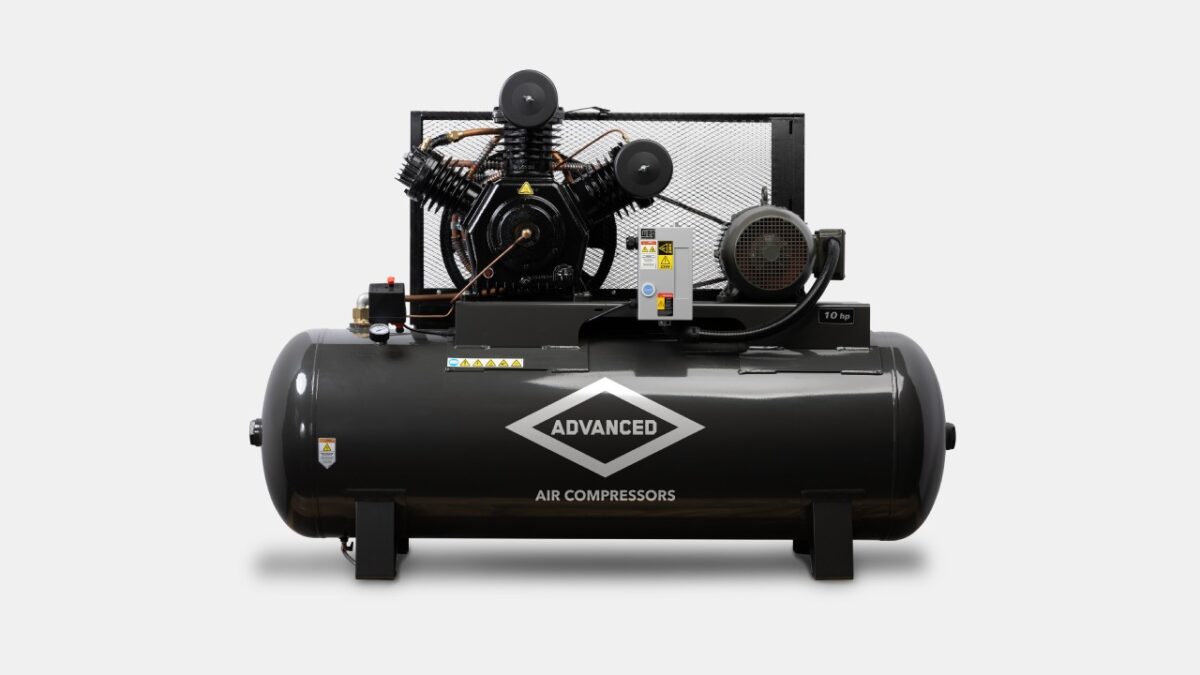There are several types of air compressors, and they each have applications where they excel. However, for industrial air compressor options, only two types are the most common. These are reciprocating and rotary screw air compressors. There are several other varieties or air compressors that are used for unique applications, which can include rotary vane, rotary scroll, rotary tooth, and the list goes on.
Reciprocating Compressors
Piston Compressors
These are some of the most versatile and common air compressors and are typically smaller or less in horsepower. They use one or more pistons to force air into a small space, through a series of valves, increasing its pressure, then discharged out of the pump. Where the air goes next depends on the application. Common discharge destinations include compressed air tanks and compressed air piping.
This type of compressor is best used when an intermittent duty cycle is called for or in relatively low air demand operations. For example, if an air tank needs to be filled every so often instead of constantly, a piston air compressor is usually a good choice. The same goes for situations where you need to be able to emit a burst of compressed air from a hose every so often.
Notably, piston air compressors can be found in everything from home tire fillers to giant natural gas processing plants. When sized appropriately and in the right conditions, a piston reciprocating air compressor should last at least 15 years but in many cases can last decades!
Diaphragm Compressors
These reciprocating compressors use a diaphragm to compress the air or gas instead of a piston. The diaphragm is oscillated to compress and expand the air/gas within a chamber. Since the air or other gas never contacts the lubricated parts of the machine, there is no chance of the gas being contaminated by oil. Because of this, they are preferred when it is essential that contamination does not occur at all. The diaphragm design is typically used in low flow scenarios with increased pressure requirements. The diaphragm design uses compressed air to actuate and create the higher pressure, therefore consumes more air to produce the higher pressure, these must be sized just right and takes a specialist to properly calculate.
Rotary Compressors
When a company needs an industrial air compressor that can handle a constant or fluctuating demand that requires a continuous duty cycle, rotary compressors come to the forefront. These use a variety of means to keep compressed air constantly flowing.
Helical Screw Compressors
These are good choices for applications where you need a constant supply of compressed air. They’re also excellent for various installation scenarios, whether they are fuel (gas or diesel) driven where you’ll need to bring them in on a trailer, such as road building and construction or electric motor driven with power being supplied form a residential/commercial/industrial building.
This type of compressor uses meshing rotors or otherwise know as a female and male interlock, to pull air or other gas into the front of the rotor and compress it as it travels further along the rotor towards the discharge end. The rotors form “cells” that get tighter as they move, and these both create the compression and keep the air/gas from re-expanding before it should. A discharge port on the opposite end screws allows the compressed air to and travel through the treatment to its destination.
Helical screw compressors have some advantages over their reciprocating counterparts. Since there is no on-off action, vibration and noise are reduced. The biggest advantage is that rotary screw air compressors are designed to run nonstop.
Depending on the specific model involved, lubrication can be provided by water or oil. Some models are suitable for applications where oil-free discharge is critical.
Sliding Vane Compressors
When an application requires an industrial air compressor to run in a contaminant-rich environment, these are often the best choice. They use bushings instead of bearings, and they operate at slow speeds compared to the helical screw compressor. In many industries, helical screw compressors have overtaken these despite the benefit, but they are still popular in applications involving natural gas, oil, and other non-air gas compression.
These compressors work via a series of vanes that slip into a rotor. As the pump rotates, the vanes slide along the inside wall of a cavity, bringing air into a large cavity first and then squeezing the molecules into a smaller space thus reducing the available volume and increasing the pressure as it rotates. Motion is from the intake side to the output end, and by the time the air/gas reaches the output side, it is sufficiently compressed.
Centrifugal Compressors
When you need compressed air for a huge facility, you will run into centrifugal compressors. They drive commercial refrigeration applications up to over 100 hp and can also be found in facilities that need up to 20,000 hp of compression power. These aren’t just strong machines; they can handle huge volumes of air – up to 200,000 cfm or more.
As the name implies, centrifugal compressors work by using a spinning impeller to throw gas outwards. The gas arrives in a casing volute, where its speed slows and it tries to expand, thereby increasing its pressure. Multiple stages may be used to achieve the needed pressures.
Axial Compressors
These are the titans of gas compressors. They can deliver from 8,000 to over 13 million cfm and are used in industrial machines. Jet engines use this type of compressor and can achieve even wider cfm ranges.
Like centrifugal compressors, the axial versions first cause the air or other gas to reach a high velocity, and then slow it down to increase its pressure. These compressors use a series of curved blades for the slowing process.
Which Compressors Are the Most Popular?
In most cases, an industrial air compressor that uses a piston or a helical screw will be the best choice for a shop. Few companies need the extreme capabilities of the other types, and both the piston and helical designs are well-tested and economical.
The choice between these types generally boils down to the needed duty cycle. Piston-based compressors are best for intermittent duty and/or lower cfm demand, while helical screw versions can keep the air coming constantly and at a higher volume of CFM.
Other considerations include the need for oil-free air, the harshness of the environment, and whether the machine will be stationary or brought to a job site without power.
Get Our Expert Advice When Choosing Your Next Air Compressor
At Advanced, we can easily advise you on which type of air compressor is best for your application. We’ll ask all the necessary questions and you’ll provide the needed information and within just a simple five-minute phone consultation. There is no need to guess and risk an expensive mistake.
We also offer all other types of air compressor service you may need, including electric motor repair, general air compressor repair or maintenance, air piping or system design, air compressor rental, and all the air compressor parts you need.
Our specialists are certified in all brands of air compressors, so when you call us, you are talking to skilled experts. Contact us at Advanced Air today for all the help you need.

